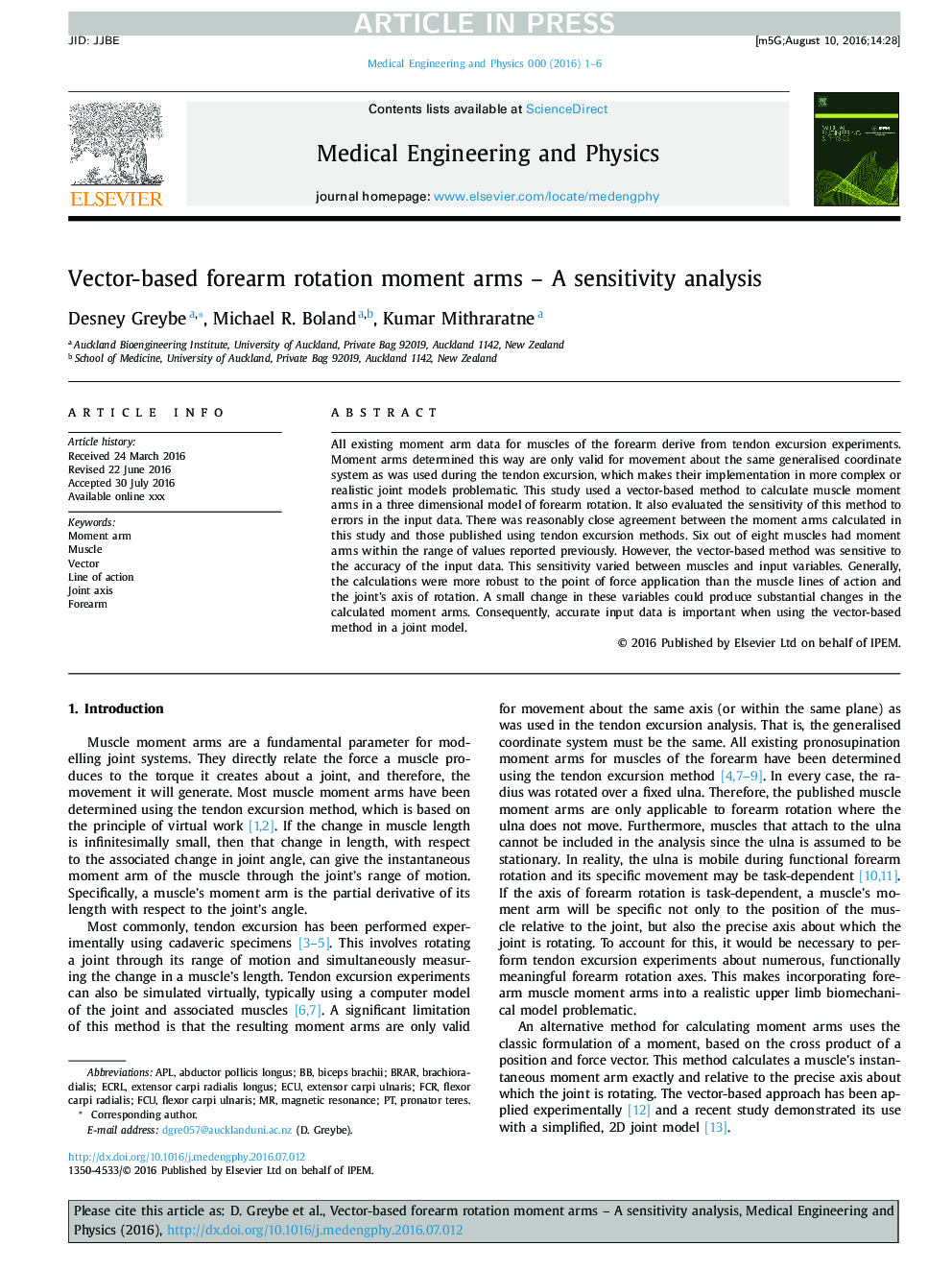| کد مقاله | کد نشریه | سال انتشار | مقاله انگلیسی | نسخه تمام متن |
|---|---|---|---|---|
| 5032798 | 1369997 | 2016 | 6 صفحه PDF | دانلود رایگان |
عنوان انگلیسی مقاله ISI
Vector-based forearm rotation moment arms - A sensitivity analysis
ترجمه فارسی عنوان
بازوهای لحظه ای چرخش ساعد بردار - یک تحلیل حساسیت
دانلود مقاله + سفارش ترجمه
دانلود مقاله ISI انگلیسی
رایگان برای ایرانیان
کلمات کلیدی
APLFCRECUPronator teresBrachioradialisextensor carpi radialis longusFCUAbductor Pollicis Longus - ابداکتور طولانیextensor carpi ulnaris - اگزنزور کرپالناریسMoment arm - بازوی لحظه ایVector - بردارMagnetic resonance - تشدید مغناطیسیLine of action - خط عملflexor carpi radialis - رادیالی فیکسور کپورbiceps brachii - رانی عضله دوسرMuscle - عضلهflexor carpi ulnaris - فلکسور کپور النوراسForearm - کف دست
ترجمه چکیده
داده های بازوی لحظه ای موجود برای عضلات ساعد ناشی از آزمایش های تاندون می باشد. سلاح های لحظه ای تعیین شده در این روش تنها برای حرکت در مورد یک سیستم مختصات عمومی تعمیم معتبر است که در طی گشت و گذار تاندون استفاده می شود، که باعث می شود اجرای آنها در مدل های پیچیده تر و واقع گرایانه مشکل تر باشد. این مطالعه با استفاده از یک روش مبتنی بر بردار برای محاسبه بازوهای لحظه ای عضلانی در یک مدل سه بعدی چرخش ساعد انجام شد. همچنین حساسیت این روش به خطاهای داده های ورودی را ارزیابی کرد. توافق قابل قبولی بین بازوی لحظه ای محاسبه شده در این تحقیق و کسانی که با استفاده از روش های گشت و گذار تاندون منتشر شده بود، توافق قابل قبولی داشتند. شش نفر از هشت عضله در حال حاضر در معرض مقادیری از قبیل گزارش شده اند. با این حال، روش بردار بر اساس دقت داده های ورودی حساس بود. این حساسیت بین عضلات و متغیرهای ورودی متغیر است. به طور کلی، محاسبات نسبت به خطوط عضلانی عمل و محور مفصل چرخش قوی تر از نقطه اعمال نیرو بود. تغییر کوچکی در این متغیرها می تواند تغییرات قابل توجهی در لحظه های محاسبه شده محاسبه کند. در نتیجه، اطلاعات ورودی دقیق هنگام استفاده از روش مبتنی بر بردار در یک مدل مشترک مهم است.
موضوعات مرتبط
مهندسی و علوم پایه
سایر رشته های مهندسی
مهندسی پزشکی
چکیده انگلیسی
All existing moment arm data for muscles of the forearm derive from tendon excursion experiments. Moment arms determined this way are only valid for movement about the same generalised coordinate system as was used during the tendon excursion, which makes their implementation in more complex or realistic joint models problematic. This study used a vector-based method to calculate muscle moment arms in a three dimensional model of forearm rotation. It also evaluated the sensitivity of this method to errors in the input data. There was reasonably close agreement between the moment arms calculated in this study and those published using tendon excursion methods. Six out of eight muscles had moment arms within the range of values reported previously. However, the vector-based method was sensitive to the accuracy of the input data. This sensitivity varied between muscles and input variables. Generally, the calculations were more robust to the point of force application than the muscle lines of action and the joint's axis of rotation. A small change in these variables could produce substantial changes in the calculated moment arms. Consequently, accurate input data is important when using the vector-based method in a joint model.
ناشر
Database: Elsevier - ScienceDirect (ساینس دایرکت)
Journal: Medical Engineering & Physics - Volume 38, Issue 10, October 2016, Pages 1109-1114
Journal: Medical Engineering & Physics - Volume 38, Issue 10, October 2016, Pages 1109-1114
نویسندگان
Desney Greybe, Michael R. Boland, Kumar Mithraratne,
